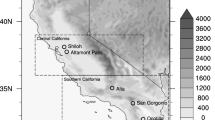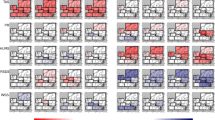Abstract
Wind energy production is expected to be affected by shifts in wind patterns that will accompany climate change. However, many questions remain on the magnitude and character of this impact, especially on regional scales. In this study, clustering is used to group and analyze large-scale wind patterns in California using model simulations from the variable-resolution Community Earth System Model (VR-CESM). Specifically, simulations have been produced that cover historical (1980–2000), mid-century (2030–2050), and end-of-century (2080–2100) time periods. Once clustered, observed changes to wind patterns can be analyzed in terms of both the change in frequency of those clusters and changes to winds within-clusters. Statistically significant capacity factors changes have been found at all five wind plant sites. Decomposition of the capacity factor changes into frequency changes and within-cluster changes enables a better understanding of their drivers. A further examination of the synoptic-scale fields associated with each cluster then provides a better understanding of how changes to large-scale meteorological fields are important for driving changes in localized wind speeds.

This figure is a reproduction of Figure 1 from Millstein et al. (2018)

This figure is a reproduction of Figure 2 from Wang et al. (2018)











Similar content being viewed by others
Notes
These wind plants names are representatives of an agglomeration of plants in close proximity to each other. Based on the calssification from California Energy Commission (CEC) (https://ww2.energy.ca.gov/maps/renewable/wind.html), Shiloh represents “Solano Wind Resource Area”, Altamont represents “Altamont Wind Resource Area”, Tehachapi represents “Tehachapi Wind Resource Area”, San Gorgonio represents “San Gorgonio Wind Resource Area”, Ocotillo represents “East San Diego Wind Resource Area”.
References
Beaver S, Palazoglu A (2006) Cluster analysis of hourly wind measurements to reveal synoptic regimes affecting air quality. J Appl Meteorol Climatol 45(12):1710–1726
Berg N, Hall A, Capps SB, Hughes M (2013) El niño-southern oscillation impacts on winter winds over southern california. Clim Dyn 40(1–2):109–121
Breslow PB, Sailor DJ (2002) Vulnerability of wind power resources to climate change in the continental united states. Renew Energy 27(4):585–598
Caliński T, Harabasz J (1974) A dendrite method for cluster analysis. Commun Stat-Theory Methods 3(1):1–27
Conil S, Hall A (2006) Local regimes of atmospheric variability: a case study of southern california. J Clim 19(17):4308–4325
Dennis JM, Edwards J, Evans KJ, Guba O, Lauritzen PH, Mirin AA, St-Cyr A, Taylor MA, Worley PH (2012) CAM-SE: a scalable spectral element dynamical core for the community atmosphere model. Int J High Perform Comput Appl 26(1):74–89
Duffy PB, Bartlett J, Dracup J, Freedman J, Madani K, Waight K (2014) Climate Change Impacts on Generation of Wind, Solar, and Hydropower in California. California Energy Commission (2014) CEC-500-2014-111
Fosberg MA, Schroeder MJ (1966) Marine air penetration in central California. J Appl Meteorol 5(5):573–589
Gates WL (1992) An ams continuing series: global change-amip: the atmospheric model intercomparison project. Bull Am Meteorol Soc 73(12):1962–1970
Ghan SJ, Liu X, Easter RC, Zaveri R, Rasch PJ, Yoon JH, Eaton B (2012) Toward a minimal representation of aerosols in climate models: comparative decomposition of aerosol direct, semidirect, and indirect radiative forcing. J Clim 25(19):6461–6476
Guba O, Taylor MA, Ullrich PA, Overfelt JR, Levy MN (2014) The spectral element method on variable resolution grids: evaluating grid sensitivity and resolution-aware numerical viscosity. Geosci Model Dev Discuss 7:4081–4117
Guzman-Morales J, Gershunov A (2019) Climate change suppresses santa ana winds of southern california and sharpens their seasonality. Geophys Res Lett 46(5):2772–2780
Hartigan JA, Wong MA (1979) Algorithm as 136: a k-means clustering algorithm. J R Stat Soc Ser C (Appl Stat) 28(1):100–108
Haupt SE, Copeland J, Cheng WY, Zhang Y, Ammann C, Sullivan P (2016) A method to assess the wind and solar resource and to quantify interannual variability over the united states under current and projected future climate. J Appl Meteorol Climatol 55(2):345–363
Hoen B, Diffendorfer J, Rand J, Kramer L, Garrity C, Hunt H (2019) United states wind turbine database. u.s. geological survey, american wind energy association, and lawrence berkeley national laboratory data release: Uswtdb v2.1. United States Wind Turbine Database
Huang X, Rhoades AM, Ullrich PA, Zarzycki CM (2016) An evaluation of the variable-resolution CESM for modeling California’s climate. J Adv Model Earth Syst 8(1):345–369
Huang X, Ullrich PA (2017) The changing character of twenty-first-century precipitation over the western united states in the variable-resolution cesm. J Clim 30(18):7555–7575
Hurrell JW, Hack JJ, Shea D, Caron JM, Rosinski J (2008) A new sea surface temperature and sea ice boundary dataset for the community atmosphere model. J Clim 21(19):5145–5153
Hurrell JW, Holland MM, Gent PR, Ghan S, Kay JE, Kushner PJ, Lamarque JF, Large WG, Lawrence D, Lindsay K et al. (2013) The community earth system model: a framework for collaborative research. Bull Am Meteorol Soc 94(9):1339–1360
Iacono MJ, Delamere JS, Mlawer EJ, Shephard MW, Clough SA, Collins WD (2008) Radiative forcing by long-lived greenhouse gases: calculations with the aer radiative transfer models. J Geophys Res Atmos. https://doi.org/10.1029/2008JD009944
Jin L, Harley RA, Brown NJ (2011) Ozone pollution regimes modeled for a summer season in california’s san joaquin valley: a cluster analysis. Atmos Environ 45(27):4707–4718
Justus C, Mikhail A (1976) Height variation of wind speed and wind distributions statistics. Geophys Res Lett 3(5):261–264
Karnauskas KB, Lundquist JK, Zhang L (2018) Southward shift of the global wind energy resource under high carbon dioxide emissions. Nat Geosci 11(1):38
Kay JE, Deser C, Phillips A, Mai A, Hannay C, Strand G, Arblaster JM, Bates S, Danabasoglu G, Edwards J et al. (2015) The community earth system model (cesm) large ensemble project: a community resource for studying climate change in the presence of internal climate variability. Bull Am Meteorol Soc 96(8):1333–1349
Li AK, Paek H, Yu JY (2016) The changing influences of the amo and pdo on the decadal variation of the santa ana winds. Environ Res Lett 11(6):064,019
Ludwig FL, Horel J, Whiteman CD (2004) Using eof analysis to identify important surface wind patterns in mountain valleys. J Appl Meteorol 43(7):969–983
Miller NL, Schlegel NJ (2006) Climate change projected fire weather sensitivity: California Santa Ana wind occurrence. Geophys Res Lett. https://doi.org/10.1029/2006GL025808
Millstein D, Solomon-Culp J, Wang M, Ullrich P, Collier C (2018) Wind energy variability and links to regional and synoptic scale weather. Clim Dyn pp 1–16
Millstein D, Solomon-Culp J, Wang M, Ullrich P, Collier C (2019) Wind energy variability and links to regional and synoptic scale weather. Clim Dyn 52(7–8):4891–4906
Morrison H, Gettelman A (2008) A new two-moment bulk stratiform cloud microphysics scheme in the community atmosphere model, version 3 (cam3). part i: description and numerical tests. J Clim 21(15):3642–3659
Neale RB, Richter JH, Jochum M (2008) The impact of convection on enso: from a delayed oscillator to a series of events. J Clim 21(22):5904–5924
Neale RB, Chen CC, Gettelman A, Lauritzen PH, Park S, Williamson DL, Conley AJ, Garcia R, Kinnison D, Lamarque JF, et al. (2010) Description of the NCAR community atmosphere model (CAM 5.0). NCAR Tech Note NCAR/TN-486+ STR
Olauson J, Edström P, Rydén J (2017) Wind turbine performance decline in sweden. Wind Energy 20(12):2049–2053
Oleson KW, Lawrence DM, Bonan GB, Flanner MG, Kluzek E, Lawrence PPJ et al. (2010) Technical description of version 4.0 of the community land model (clm) (No. NCAR/TN-478+STR). University Corporation for Atmospheric Research. https://doi.org/10.5065/D6FB50WZ
Park S, Bretherton CS (2009) The university of washington shallow convection and moist turbulence schemes and their impact on climate simulations with the community atmosphere model. J Clim 22(12):3449–3469
Park S, Bretherton CS, Rasch PJ (2014) Integrating cloud processes in the community atmosphere model, version 5. J Clim 27(18):6821–6856
Pryor S, Barthelmie R (2010) Climate change impacts on wind energy: a review. Renew Sustain Energy Rev 14(1):430–437
Pryor S, Barthelmie R (2011) Assessing climate change impacts on the near-term stability of the wind energy resource over the united states. In: Proceedings of the National Academy of Sciences
Raphael M (2003) The santa ana winds of california. Earth Interact 7(8):1–13
Rasmussen D, Holloway T, Nemet G (2011) Opportunities and challenges in assessing climate change impacts on wind energy—a critical comparison of wind speed projections in California. Environ Res Lett 6(2):024,008
Rhoades AM, Huang X, Ullrich PA, Zarzycki CM (2016) Characterizing Sierra Nevada snowpack using variable-resolution CESM. J Appl Meteorol Climatol 55(1):173–196
Rhoades AM, Ullrich PA, Zarzycki CM (2018a) Projecting 21st century snowpack trends in western usa mountains using variable-resolution cesm. Clim Dyn 50(1–2):261–288
Rhoades AM, Ullrich PA, Zarzycki CM, Johansen H, Margulis SA, Morrison H, Xu Z, Collins WD (2018b) Sensitivity of mountain hydroclimate simulations in variable-resolution cesm to microphysics and horizontal resolution. J Adv Model Earth Syst 10(6):1357–1380
Small RJ, Bacmeister J, Bailey D, Baker A, Bishop S, Bryan F, Caron J, Dennis J, Gent P, Hm Hsu et al. (2014) A new synoptic scale resolving global climate simulation using the community earth system model. J Adv Model Earth Syst 6(4):1065–1094
Staffell I, Pfenninger S (2016) Using bias-corrected reanalysis to simulate current and future wind power output. Energy 114:1224–1239
Taylor MA, Fournier A (2010) A compatible and conservative spectral element method on unstructured grids. J Comput Phys 229(17):5879–5895
Taylor KE, Stouffer RJ, Meehl GA (2012) An overview of CMIP5 and the experiment design. Bull Am Meteorol Soc 93(4):485
Ullrich PA (2014) SQuadGen: spherical quadrilateral grid generator. University of California, Davis, Climate and Global Change Group software http://climate.ucdavis.edu/squadgen.php
Wang H, Schubert SD (2014) Causes of the extreme dry conditions over california during early 2013
Wang M, Ullrich PA (2018) Marine air penetration in California’s Central Valley: Meteorological drivers and the impact of climate change. J Appl Meteorol Climatol. https://doi.org/10.1175/JAMC-D-17-0089.1
Wang M, Ullrich PA, Millstein D (2018) The future of wind energy in california: future projections with the variable-resolution cesm. Renew Energy 127:242–257
Ward JH Jr (1963) Hierarchical grouping to optimize an objective function. J Am Stat Assoc 58(301):236–244
Westerling AL, Cayan DR, Brown TJ, Hall BL, Riddle LG (2004) Climate, santa ana winds and autumn wildfires in southern california. Eos, Trans Am Geophys Union 85(31):289–296
Wilks DS (2011) Cluster analysis. In: International geophysics, vol 100. Elsevier, Amsterdam, pp 603–616
Yu L, Zhong S, Bian X, Heilman WE (2015) Temporal and spatial variability of wind resources in the United States as derived from the climate forecast system reanalysis. J Clim 28(3):1166–1183
Zarzycki CM, Jablonowski C (2014) A multidecadal simulation of atlantic tropical cyclones using a variable-resolution global atmospheric general circulation model. J Adv Model Earth Syst 6(3):805–828
Zarzycki CM, Jablonowski C, Taylor MA (2014a) Using variable-resolution meshes to model tropical cyclones in the community atmosphere model. Mon Weather Rev 142(3):1221–1239
Zarzycki CM, Levy MN, Jablonowski C, Overfelt JR, Taylor MA, Ullrich PA (2014b) Aquaplanet experiments using CAM’s variable-resolution dynamical core. J Clim 27(14):5481–5503
Acknowledgements
The authors want to thank the Craig Collier, Daran Rife, and Christopher Hayes for the helpful conversations throughout this project. We would further like to thank the two anonymous reviewers for their thorough evaluation of the manuscript and valuable suggestions. This work was funded by the California Energy Commission under the Electric Program Investment Charge Grant, “EPC-15-068: Understanding and Mitigating Barriers to Wind Energy Expansion in California.” This work was supported by the U.S. Department of Energy (DOE) under Lawrence Berkeley National Laboratory Contract No. DE-AC02-05CH11231. This project is further supported by the National Institute of Food and Agriculture, U.S. Department of Agriculture, hatch project under California Agricultural Experiment Station project CA-D-LAW-2203-H. Author Ullrich is supported by Department of Energy Office of Science award number DE-SC0016605,“An Integrated Evaluation of the Simulated Hydroclimate System of the Continental US”.
Author information
Authors and Affiliations
Corresponding author
Additional information
Publisher's Note
Springer Nature remains neutral with regard to jurisdictional claims in published maps and institutional affiliations.
Electronic supplementary material
Below is the link to the electronic supplementary material.
Rights and permissions
About this article
Cite this article
Wang, M., Ullrich, P. & Millstein, D. Future projections of wind patterns in California with the variable-resolution CESM: a clustering analysis approach. Clim Dyn 54, 2511–2531 (2020). https://doi.org/10.1007/s00382-020-05125-5
Received:
Accepted:
Published:
Issue Date:
DOI: https://doi.org/10.1007/s00382-020-05125-5




